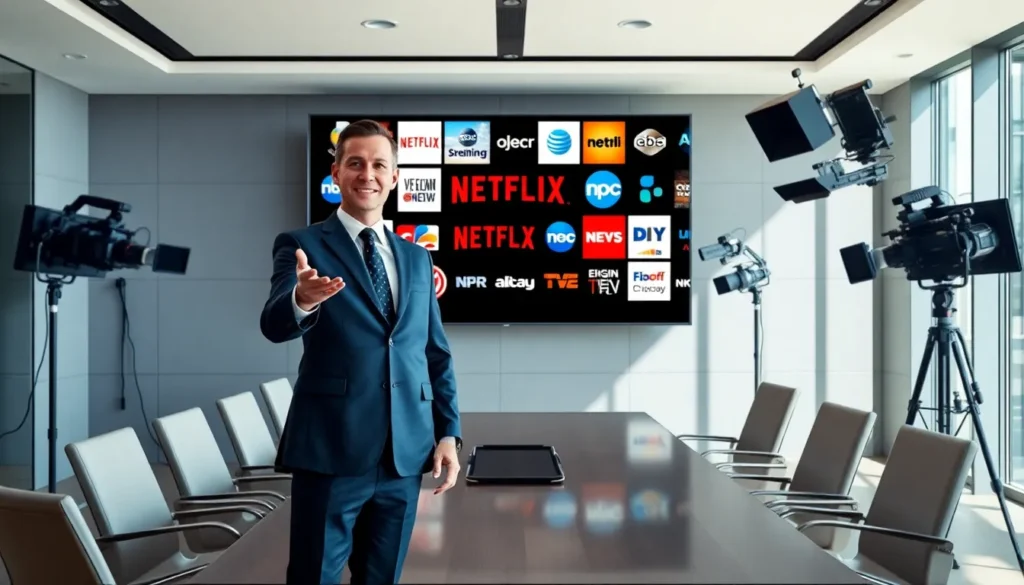Table of Contents
ToggleBroadcast media has transformed the way people consume information and entertainment. From heart-racing news updates to side-splitting sitcoms, there’s something for everyone. In this text, we’re diving deep into the world of broadcast media, think of it as the ultimate buffet of audio-visual delights. So grab your remote and make yourself comfortable, because understanding these types of media is easier than finding the best seat in your living room.
Introduction To Broadcast Media

Broadcast media refers to the distribution of audio and visual content to a wide audience via electronic transmission. This umbrella term encapsulates various formats, including television, radio, and digital platforms. The landscape of broadcast media has evolved dramatically, especially in recent years, as technology has developed and consumer preferences have shifted. The key to appreciating broadcast media lies in understanding how these types interact with audiences and their respective strengths and weaknesses.
Television Broadcast Media
Television remains one of the most popular forms of broadcast media, captivating millions with its unique blend of visuals and audio. Offering a wide variety of genres, from gripping dramas to reality shows, television programming caters to diverse tastes.
TV broadcasts can be categorized into several types:
- Cable Networks: These channels provide a wealth of content, often specialized to attract specific demographics. Channels like HBO and CNN exemplify how targeted programming can create loyal audiences.
- Public Broadcasting: Catering to educational and cultural programming, public networks like PBS offer shows that inform, inspire and entertain without the crutch of advertisements.
- Streaming Services: Platforms like Netflix and Hulu have revolutionized how viewers engage with television, allowing them to consume content when and where they want. This shift recognized a changing consumer behavior, emphasizing on-demand rather than scheduled viewing.
Each of these platforms demonstrates how television continues to shape conversations and cultural narratives.
Radio Broadcast Media
Even though the rise of television and digital platforms, radio broadcast media retains a loyal following. The convenience of radio allows audiences to tune in while multitasking, driving, exercising, or even cooking dinner.
Radio broadcasts are categorized into a few types:
- AM Radio: This frequency modulates in amplitude and is often used for talk radio, news, and sports programs. Its long-distance capabilities make it ideal for reaching rural audiences.
- FM Radio: Featuring greater sound quality, FM radio often focuses on music and entertainment shows, catering to younger demographics.
- Internet Radio: With the surge of online platforms, internet radio allows for niche programming that appeals to specialized tastes, from indie music to foreign languages. This evolution can be attributed to the easily accessible technology we now have at our fingertips.
Digital Broadcast Media
Digital broadcast media is the modern frontier, combining the best of both television and radio. This form emphasizes user engagement, enabling audiences to interact with content more than ever before.
Here are some highlights of digital broadcast media:
- Podcasts: Offering an endless array of topics, podcasts have surged in popularity. Their convenience allows users to listen on-the-go, making them the perfect choice for in-depth explorations of niche subjects.
- Webcasts: These live streams provide a platform for real-time interaction, allowing audiences to communicate directly with hosts. From gaming streams on Twitch to professional webinars, webcasts make content feel immediate and personal.
- YouTube and Online Video Platforms: This realm has exploded over recent years, with both amateur and professional content creators reaching global audiences. YouTube offers countless channels ranging from education to comedy, catering to every conceivable interest.
Comparative Analysis Of Broadcast Media Types
Each type of broadcast media serves unique purposes and audiences. Television, even though its evolving landscape, remains strong due to its visual storytelling and production quality. Radio excels in accessibility and continuity, providing audiences with a familiar, comforting presence. Digital broadcast media shines in its flexibility and variety, enabling creators to connect with niche audiences directly.
When comparing these types, consider factors like engagement, immediacy, and audience reach:
- Television often has higher production costs but delivers high-quality content.
- Radio leverages its affordability and accessibility, connecting with listeners wherever they are.
- Digital Media thrives on diversity, constantly evolving to meet the preferences of tech-savvy audiences.
Radio may not have the flashy visuals of television, but its ability to create an emotional connection keeps it relevant, while digital media’s on-demand capabilities reshape how we view content.
Emerging Trends In Broadcast Media
In the rapidly changing landscape of broadcast media, several trends are emerging that shape how content is created and consumed.
- Personalization: Algorithms on platforms like Netflix and Spotify curate content based on user preferences, making viewers feel more connected to what they watch or hear.
- Augmented Reality (AR) and Virtual Reality (VR): These technologies are beginning to find their place in broadcast media, providing immersive experiences that transform traditional storytelling. As these tools improve, audiences can expect more engaging narratives that captivate attention.
- Short-Form Content: Platforms like TikTok are changing content creation dynamics, emphasizing brief, impactful storytelling. This trend toward brevity influences all media as audiences’ attention spans continue to shorten.




